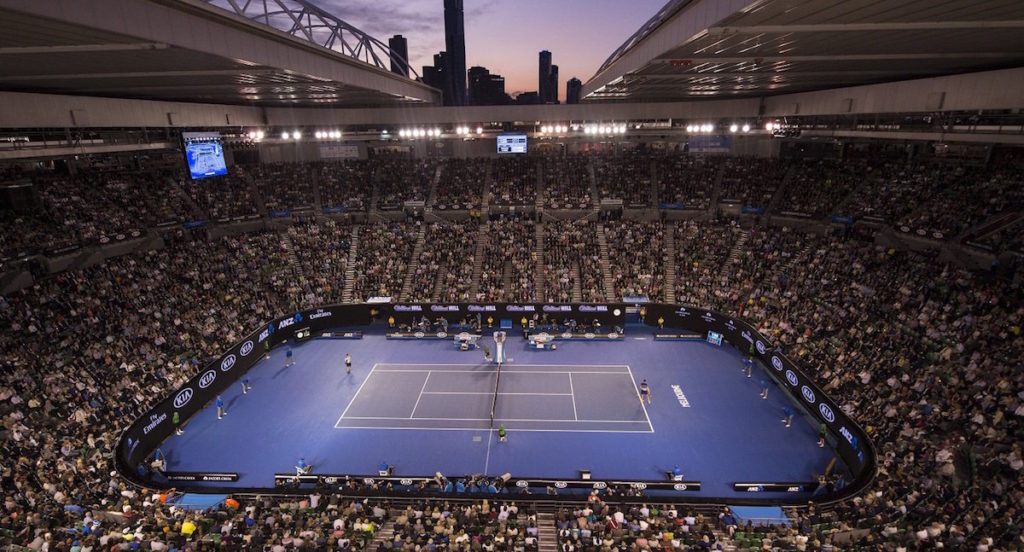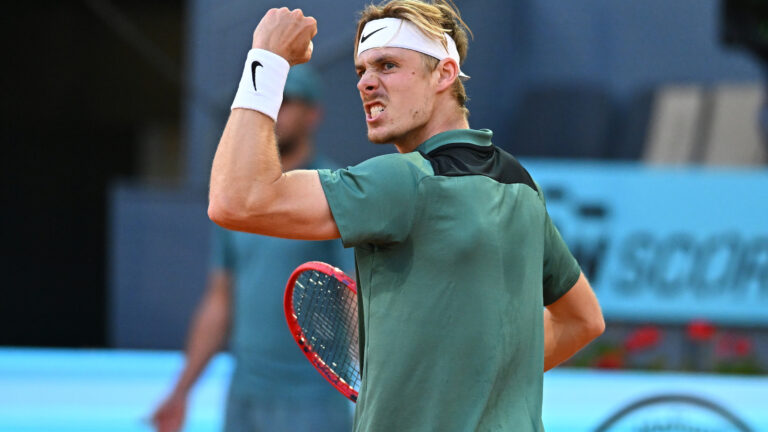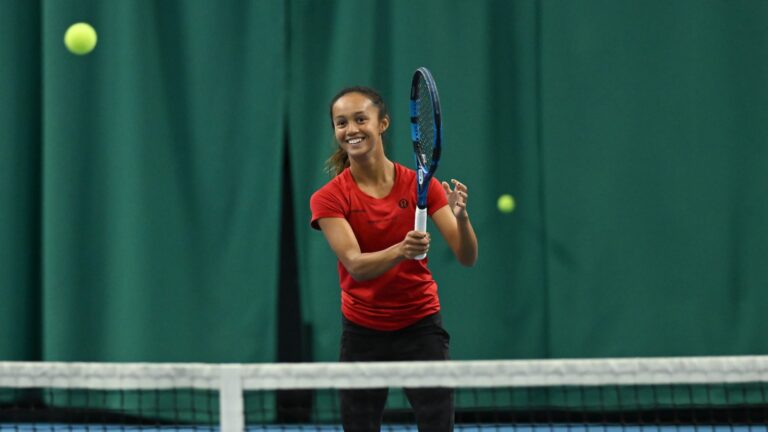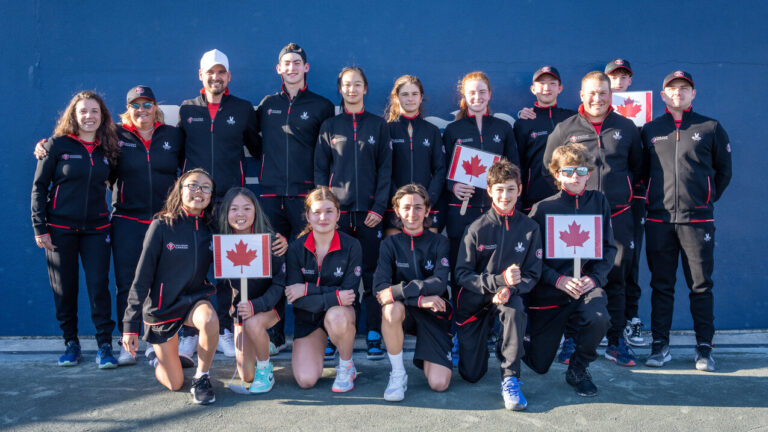
Over the past three weeks, Milos Raonic had beaten the No. 4 player in the world, Stan Wawrinka (Aussie Open round-of-16), the No. 3 player Roger Federer (Brisbane International final) and was two-sets-to-one up on the No. 2 Andy Murray (Aussie Open semifinals) on Friday night with the possibility of playing No. 1 Novak Djokovic in Sunday’s final.
He had been playing at an entirely new level since arriving in Australia earlier in January and almost anything seemed possible for him – maybe with the exception of beating the rarified Djokovic. Certainly after taking the third set tiebreak with a 211 km/hr ace to lead 6-4, 5-7, 7-6(4) against Murray in Rod Laver Arena on Friday night, he seemed a more compelling candidate for the final than the Scot.
It was a highly-competitive match to that point with one service break each set and Raonic leading in the total points tally 101-99.
Then Raonic called for the trainer leading 2-1 on serve in the fourth set and left the court for five minutes for treatment. He seemed fine at first when he returned but soon there were clear signs of limitations in his service motion and discomfort with certain movements.
Murray broke serve to lead 4-3 in the fourth set and then saved a break back point in the following game with a forehand volley winner, letting out a loud roar. Raonic, despite being somewhat diminished managed two more break points when Murray served for the set at 15-40, but the Brit played them well and eventually took the set when Raonic misfired long with a service return.
The injury issue was getting more and more difficult to manage and, when Raonic double-faulted to lose his serve in the opening game of the final set, he smashed his racquet twice on the court.
“I guess that was just the whole frustration of everything getting out,” he would say later. “I don’t think that’s like myself but sometimes it’s a little bit too much to keep in.”
Murray broke again to lead 3-0 and soon 4-0 as it became obvious Raonic was no longer physically capable of remaining competitive with his sharp and still very focused opponent.

The final score was 4-6, 7-5, 6-7(4), 6-4, 6-2 for Murray in a four-hour-and-three minute match. Raonic supporters obviously were disappointed that their guy was unable to finish the way he had started – matching Murray from the baseline, keeping him off balance with his serve and covering the net brilliantly – so much so that he was 16 for 20 (80 per cent) there through the first four sets. And that’s against one of the best passing shot artists in the game.
Raonic entered the interview room about 25 minutes after the match head down, disconsolate, and doing his best to keep it together. “It’s unfortunate,” he said about the way things had finished, “probably the most heartbroken I’ve felt on the court.”
He explained it was his right adductor that was the issue, that he had trouble pushing off on his right leg and that it started bothering him in the middle of the third set.
“I struggled with it a little bit in Brisbane,” he said, “but it was not an issue so far in Melbourne.”
He battled right to the end and when asked if he might have risked injury by continuing, he responded, “I couldn’t have cared less what could have happened on the court. I was in my second (Grand Slam) semifinal. I was in a better position than I was last time (a 6-4, 6-4, 6-4 loss to Federer in the 2014 Wimbledon semifinals). Regardless of what situation I was in, I was going to play and try to do whatever I could.”
“He definitely slowed down in the fifth set for sure,” Murray said about Raonic, “which is unfortunate. It would have obviously been nice to play a more competitive fifth set because he was struggling with his serve and his movement.”
Martin Laurendeau from Montreal sat in the courtside box with Raonic’s support team. “It was a heck of a match,” Canada’s Davis Cup captain said, “two sets to one and in the middle of the fourth set he was really in a position to win the match. But at one point I saw him serving and I could tell that something wasn’t right. He was grimacing and you knew something was going on. The trainer came on and you could see it was something around the hip. He wasn’t moving as well, he couldn’t serve as well and it really turned the match around. It’s too bad for him but it was really great tennis up until then. It’s an unbelievable start to the year – winning Brisbane beating Federer, beating Wawrinka and (Gael) Monfils. He beat Wawrinka going to the net, he beat Monfils playing from the baseline. Today there were a lot of top-four player caliber rallies, and that’s where he wants to be. It’s a super start to the season and it’ll give him confidence. He’s improved in so many areas that it’s really fun to watch him play.”

The high in Melbourne on Friday was a chilly 18 degrees. “It was cold tonight, the ball didn’t travel as fast and it was more laboured for Milos,” Laurendeau noted. “If he’d played in the middle of the day when it was hotter, the ball would have gone faster and it would have helped him. It was really cold. It slowed down the playing conditions so it gave a little advantage to Andy.”
Who knows if the unusual Aussie summer weather conditions contributed to Raonic’s injury?
“Milos started the match really fast,” Laurendeau summed up. “Andy did well to stay competitive with him and then he was able to pass him in the final turn.”
Raonic was morose and melancholy afterward and not inclined to talk much post-match, not even to members of his team.
But he was able to acknowledge his achievements this year even from the dark space he was in immediately after the match. “If this hadn’t happened 20 minutes ago,” he said at his media conference, “there’s a lot more positive to take from the situation than there are negatives by magnitudes.”
His next tournaments are slated to be the ATP 250 event in Delray Beach, Florida, beginning February 15 to be followed a week later by the ATP 500 in Acapulco, Mexico.
While he claimed he had no interest in consulting a doctor in the moments after the match, he did say that he could walk normally without pain, which was a positive sign.

So a sensational beginning to the 2016 season has come to an agonizing, anti-climactic conclusion. On the verge of a possible first Grand Slam final following a run of by far the best tennis of his life, Raonic was thwarted by something out of his control.
After a 2015 year marred by foot surgery in May and back spasms that plagued him during the summer and fall, he had been healthy and able to raise his game to a new plateau. “After the difficulties I had,” Raonic said, “not finishing the (2015) year, many other aspects, not knowing where I stood, this was the ideal way to start. But you can’t take away the hurt from the way the story played out today.”
It has been extraordinary to witness his progress from the beginning of 2016. At some points observers have wondered if the ceiling for him was to be a sort of upgraded version of a big-sever like John Isner.
After his remarkable performances in Brisbane and particularly in the crucible of best-of-five competition at the Aussie Open, the sky seems to be the limit for Raonic.
His level of play has taken a quantum leap. He has bypassed contemporaries such as Kei Nishikori and Grigor Dimitrov and now stands at the head of the class of candidates to be the first of the next generation to win a Grand Slam title. The biggest question mark about Milos Raonic is no longer if can he mix it with the big boys. It’s can he remain fit enough to continue to play tennis at the elite level he displayed these past four weeks.
Nestor goes No. 9

A full 14 years since he won his first Grand Slam doubles title (with Mark Knowles) at the 2002 Australian Open, on Saturday night Daniel Nestor will try to win his second title at Melbourne Park and the ninth overall of his career.
On Thursday, Nestor and his partner Radek Stepanek saved three set points in a wild tiebreak on their way to beating Pablo Cuevas and Marcel Granollers 7-6(11), 6-4 in semifinal action on Court 3 at the Australian Open.
In Saturday night’s final, after the Serena Williams–Angelique Kerber women’s final, the unseeded Nestor and Stepanek will face No. 7 seeds Jamie Murray of Britain and Bruno Soares of Brazil.
“We were fortunate to win the first set,” Nestor said about the semifinal. “They had us up a break early in the match and also up a mini-break in the tiebreak. The first set was key because it was so close and we got up right away in the second set. It could have been the exact opposite if we’d lost the first set.
“I thought we both served fairly well, especially Radek, and we played a solid match.”
Comparing the success he had with Edouard Roger-Vasselin of France when they played together last summer – runner-up at the ATP 1000 Rogers Cup and title at the ATP 1000 in Cincinnati – and with what’s happened with Stepanek, Nestor said, “Radek’s similar to Edouard in gamestyle. Just like him he’s played high-level doubles and singles and he understands doubles. When you play with someone like that usually you’re going to gel.”
Looking ahead to Saturday night, Nestor said, “I’m 1-3 in finals here (title in 2002 and runner-up in 1995, 2003 and 2010) and it’s going to be our toughest match for sure. These guys are very confident and playing well. As I’ve said recently, Jamie is making a case to be the best doubles player in the world right now. He’s made three straight Grand Slam finals and he’s won Davis Cup. He’s picked up right where he left off with a new partner (formerly Aussie John Peers) and he’s playing great tennis. Bruno is very capable, he’s been a top player. So they’re a very difficult team. We understand that the only way we’re going to win is if we play great and go for it.”
Specifically about Murray, 29 and Andy’s older brother by 15 months, Nestor said, “I think there have been times in his career – when he was younger – that he didn’t serve as well. Now he serves well and he’s very confident with his serve. He always been one of the best net players and he’s returning great too. As I said, I think he’s playing the best tennis of any doubles player right now.
“Bruno is playing great too. I’ve been watching them play and he kind of struggled at times last year but he’s very comfortable with Jamie.”

About joining forces with the 37-year-old Stepanek, Nestor said, “I knew I was in a situation where I could be scrambling because I waited as long as possible for Edouard at the end of last year. Finally (Julien) Benneteau was healthy, so they stayed together.
“I thought it was a really good opportunity to play with Radek. At my age, I haven’t been doing that well the last few years and obviously in the back of my mind retiring is always there. Being away from my family, I want to play with somebody that I feel I can win with, and I felt like that with Radek. There’s not many guys – more from my side – that I feel I can win with. I have one right now.”
They plan to play the whole 2016 season together. “He was probably in a desperate state too,” Nestor said about Stepanek and the origins of their getting together. “He’s ranked 75 and, at the time we talked he was below 100 and then he made the semis of Bercy with (Tomas) Berdych. So he had a choice to play with some Czech guys or I guess he was happy that I asked him.
“It worked out really well for both of us.”
There could be another reason Nestor choose Stepanek – they have played each other 15 times in doubles and Stepanek has come out on top on nine of those occasions.
Finally, with Milos Raonic and Vasek Pospisil deciding to play together at the Olympics this summer, Nestor was kind of left out in the cold. But, if he gets his current No. 19 ATP individual doubles ranking up to the Top 10, he would have the option to choose a partner for the Games in Rio de Janeiro.
A victory in Saturday’s final would move him up to about No. 8, a loss and he would be about 14th.
“When Vasek decided to play with Milos, that’s something that I thought about,” Nestor said about getting his ranking into the Top 10 for a chance at his sixth career Olympics – every one since Atlanta in 1996. “But it wasn’t what was motivating me. I just thought ‘okay, that’s my only chance’ but now it’s reality and it’s a serious opportunity to play another Olympics. But I don’t know how the qualification process works. Even if I’m Top 10, it doesn’t mean the COC (Canadian Olympic Committee) will accept us (he and a Canadian partner) as a team. I’ve seen that happen before. Hopefully, they would.”
Australian post card

Federation Square is the main gathering spot in central Melbourne. During the Australian Open, there’s a jumbo screen there with coverage of the matches. Above is a rather sparse gathering on a night last week when Aussie Daria Gavrilova was the main attraction.


